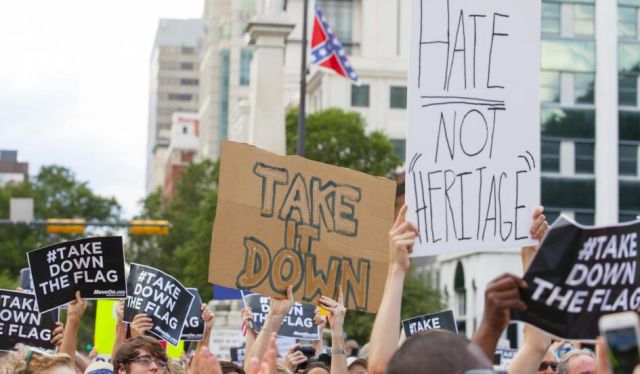
“Protesters rallied in Columbia on Tuesday to demand the flag's removal from South Carolina's state capitol,” the BBC reported on June 24.
The protest comes in the aftermath of the racist mass murder carried by Dylann Roof on June 17 in Charleston, South Carolina. Roof, who killed nine people in a historic African American church, was photographed with the flag, which still flies over the state's capitol.
The BBC reported: “Efforts are under way in four other states — Texas, Mississippi, Virginia and Tennessee — to remove state-sponsored Confederate tributes. And some major retailers like Amazon and Walmart are also removing it.”
In the light of Roof's terrorist attack, protests have spread across the country to call for the flag to be pulled down and removed from official institutions, not just in South Carolina, but across the South.
The history of the flag — its long connections with racism, segregation and violence — makes the fact that it still flies appalling in the eyes of many.
The flag, also referred to as the “Rebel Flag”, was not the national flag of the Confederate States of America (CSA), formed in 1861 when seven slave states seceded from the United States. Rather, it was the battle flag of the CSA's Confederate Army. The national flag for the Confederate state itself went through several phases and design.
The 1861-65 Civil War, sometimes referred to as the Second American Revolution, has been misrepresented and simplified both by the apologists for Southern slavery and by mainstream liberal historians. Fundamentally, the war was a struggle between two competing social orders that could no longer co-exist within the United States.
In the South, a slave-owning class based their wealth in plantation agriculture. They enslaved hundreds of thousands of Black people, who had been stolen from Africa over the course of centuries.
Between these two classes sat layers of small business people, poor farmers who could not afford slaves and landless and impoverished white labourers who would make up the bulk of the Confederate Army.
In the North, a dynamic capitalist mode of production was emerging, fed by growing factories in the coastal cities. A powerful class of merchant bankers and industrialists presided over this more productive system.
The contradictions in this hybrid social order, with slavery in the South and capitalism in the North, was increasingly brought to the surface by the US's westward expansion.
The theft of increasingly large amounts of land in wars of colonial aggression against indigenous people and Mexico exacerbated social tensions. Settlers from both the North and the South vied for control over the new land being brought into the growing US.
This economic tension led to the Civil War, a war which endeavoured to consolidate the power of Northern capitalism by disempowering the Southern slave-owning elites.
During the war, it became clear that to defeat the South, it was necessary to abolish slavery. This was both to economically defeat the slavocracy and to mobilise the mass of Black slaves and white abolitionists.
Countless Black people and many white abolitionists fought and often gave their lives to defeat slavery. But this did not mean the US state that officially abolished slavery was committed to anti-racism. For instance, Abraham Lincoln accompanied his famous signing of the Emancipation Proclamation in 1863 with approval for the mass execution of indigenous resistance fighters.
Nonetheless, in winning the Civil War and enforcing the abolition of slavery — or often simply legalising the reality of slaves liberating themselves amid a collapsing social order in the South — the forces of the North played a progressive role.
In the years that followed the Civil War, during a period known as the Reconstruction between 1863-1877, many, often radical, democratic gains were won by Black people.
During the Reconstruction, Black people were able to establish some degree of economic security and won many political positions. But this process did not last — and met with a violent counter-revolution to smash the democratic gains of the Black population in the South.
The defeat of the Reconstruction led to what became known as the racist Jim Crow laws of legalised segregation that enforced a white supremacist order.
In this period, the Confederate battle flag became a symbol of racial violence. It flew over countless terrorist attacks by the Ku Klux Klan and lynchings of Black people. It became adopted to symbolise the entire social movement that, unable to re-establish slavery, sought to maintain a social order that reduced black people to a lesser status.
In South Carolina, this flag of the Klan and the lynch mobs flies over the state capitol to this day. The flag was hoisted up in 1961 — in direct response to the rising civil rights movement.
The flag was raised to send a direct message to Black people in that state about where the government of South Carolina stood on the issue of segregation and voting rights.
This is the context where outraged protesters are calling for the flag to be torn down.
Like the article? Subscribe to Green Left now! You can also like us on Facebook and follow us on Twitter.